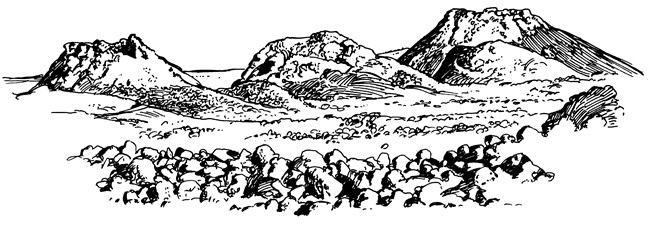
NPS Illustration Big Craters and Spatter ConesBackground InformationBig Craters and the Spatter Cones are two of the most interesting features in the park. At one time, a number of trails crisscrossed the Spatter Cones and Big Craters. An extensive effort was made to rehabilitate this area. The importance of staying on the paved trails cannot be stressed enough. Extreme caution and supervision are required. The climb to the top of Big Craters is short (less than 1/4 mile) but steep. Be sure your groups stop to rest on the way up. To prevent members of your group from charging ahead, the group leader should stay in front. When at the top, keep a safe distance from the crater's edge. Do not let your students run down the side of these features. The viewing area at the top of both Spatter Cones is limited. It is a good idea to divide large groups, allowing only five or six members of your group to approach at one time. Climbing on the bars and cables at the Spatter Cones is dangerous and strictly prohibited. PLEASE DO NOT DROP ANY OBJECT, INCLUDING ROCKS, INTO THE SPATTER CONES. Cleaning them out is dangerous and costly. Parking AreaIntroductionThe story of Craters of the Moon begins with the story of the Snake River Plain. The Snake River Plain is a vast expanse of lava that cuts across Southern Idaho like a giant smile. It extends from the Oregon border all the way to Wyoming. The Snake River Plain contains an assortment of lava flows, volcanoes, and volcanic features of varying ages. Although there are many theories on the formation of the Snake River Plain and its volcanic features, most geologists agree on the "Mantle Plume Theory" as the best explanation for the existence and location of the plain. Very briefly, the theory states that uneven heating within the core of the earth allows some material to become slightly hotter than the surrounding material. As the temperature of this material increases, it becomes less dense and buoyantly rises through the cooler, denser material surrounding it. This hot material, consisting of molten rock, is called magma. When magma erupts on the surface it is called lava. These plumes of magma are often referred to as "hot spots." The Snake River Plain is surrounded by mountain ranges that were created through "Basin and Range" faulting. Basin and Range faulting occurs when the earth's crust is stretched and pulled in two different directions causing it to fracture. As the crust fractures, large blocks of the crust are uplifted, creating mountain ranges, and as large blocks are down-dropped, they create valleys. This pattern of mountain range - valley, mountain range - valley, can be seen in the areas surrounding the plain. Basin and Range faulting is also thought to have created numerous fault zones, also known as rift zones, that run across the Snake River Plain in a north to south direction. These fault zones are made up of a series of long parallel surface and sub-surface cracks in the earth's crust. Craters of the Moon sits on top of one such rift zone, known as the Great Rift. Since rift zones represent weak areas in the earth's crust, it is common for them to be the site of volcanic eruptions. Stop #1Fissure-Type Eruptions(Halfway to the top of Big Craters) Stop #2Big CratersBig Craters is a great example of how a fissure eruption gradually changes from a long curtain of fire to a single main vent. The fissure beneath Big Craters probably extended from the Spatter Cones to North Crater. Eruptions took place at many different points along the fissure. Big Craters is called a "cinder cone complex" because it's made up of as many as nine separate vents. Some of the smaller vents sit inside of larger ones. The cinders that make up Big Craters are varying shades of red, brown, and black. Some cinders are even iridescent purple and gold. Red cinders, like red lava rock, are the result of iron oxidization when the cooling cinders come in contact with steam. The iridescence is caused by a microscopically thin layer of volcanic glass that formed when the super hot cinders hit the cool air. Stop #3Spatter ConesThese "miniature" volcanoes form during the final stages of a fissure type eruption. As gases escape and pressure is released, the lava becomes thick and pasty. When these sticky globs of lava plop to the surface, they pile up to form spatter cones. Most spatter cones are much smaller than cinder cones. They are rarely more than 50 feet high. The steep sides of a spatter cone protect the ice and snow inside from the hot summer sun. One spatter cone, Snow Cone, has been known to hold ice all summer. Parking AreaSummaryThe Snake River Plain contains many different rift zones, one of which is the Great Rift. Rift zones are known for their spectacular fissure-type eruptions. The early stages of an eruption tend to be violent, as the gas charged lava forms fire fountains and cinder cones such as Big Craters. As much of the gas and pressure is released, the later stages are almost gentle, forming massive lava flows and spatter cones. Volcanic eruptions along the Great Rift have created 25 cinder cones, 60 separate lava flows, and numerous spatter cones. |
Last updated: November 2, 2021
